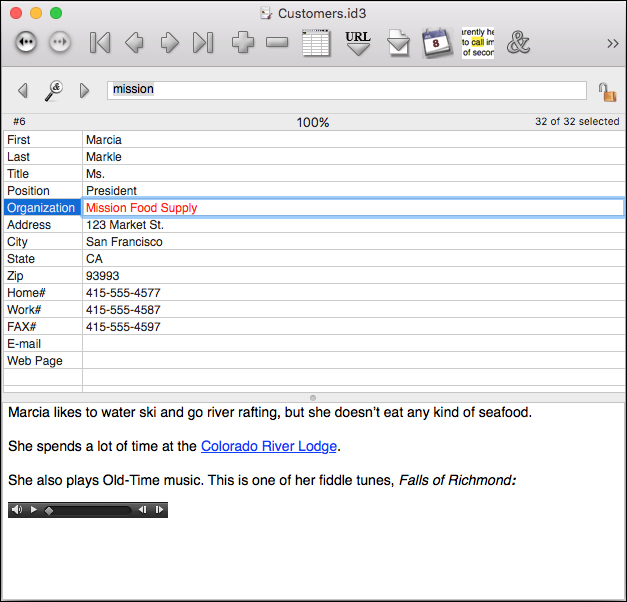Efficient Data Entry
in
Field-based Datafiles
Introduction
Many users simply use iData Pro to store random
information of one kind or another. This is often done using
freeform
datafiles, and the user just adds new records as needed.
However, there are many cases where the use of fields is important
for
more "structured" data. A good example is a contact file, where each
record contains specific bits of information about a particular
person.
Here's an example:
It is certainly possible to create such a datafile and then just add
records from time to time as needed.
However, sometimes you may have a large quantity of data in some
other
format (e.g. printed) that you need to get into a datafile as
efficiently as possible. This page will provide a few ideas about
how
to do this.
Basic Information
You can enter data in either List View or Data View.
Because List View displays as a table, with records as rows and
fields
as columns, it is particularly useful if you are creating many
records
in one sitting and need to be able to see some of the records that
you've entered previously.
On the other hand, Basic View, which shows one record at a time,
with
fields as rows, may be a bit simpler, since it's not as easy to edit
the wrong record.
You can get to be pretty efficient in either view by using command
keys, but moving among fields is somewhat different.
Work Flow
Starting With a New Record
1. Use command-= (command-equal) to add the new
record.
2. Depending on your needs, you can set a datafile to add new
records
at the beginning of the datafile, at the end of the datafile, or
after
the current record.
a, Use command-option-comma
to bring up the Settings
dialog.
b. Click the Always
tab.
c. Make your selection under Always add new records:.
d. Click the Save
button.
3. You can use shift-command-V
to switch between Basic View and List
View. (If you end up doing this a lot, you should make sure that the
upper left corner of the windows for both views are in approximately
the same location to minimize window movement.
Data Entry
1. When a new record is created, the first field of the new record
will become active.
2. After typing something (or nothing) into a field, type tab to move
to the next field. (Typing tab
with the last field active will take you back to the first field.)
Type shift-tab
to move to the previous field. (Typing tab with the first field active will take you back
to the last field.)
You can also click in any field to make it active.
3. There are several ways to select all of the text in a field so
that it can be overwritten:
a. Type command-A
to select all the text in an active field.
b. Double-click in the current field to select all the
text in that field.
c. Click on a field name to select all the text in that
field (in the current record).
4. Type command-\ (command-backslash) to move the
entry point to the
Freeform Text Area. Or, just click in the Freeform Text Area.
You can also type command-[ (command-left
bracket)to make the Find Box active, or type command-] (command-right bracket) to make
the current field active.
5. Once you're satisfied with the current record, you can type
command-= to add another
record. You may want to type command-S
to save your
changes at this point.
Other Stuff
1. Many experienced users of iData have developed the habit of
typing the return key to
move between records.
In ancient times (starting in around 1988), we
set up iData's
earliest predecessor, QuickDEX, so that when the Find Box was empty,
the user could type the return
(or enter) key to go to
the next record.
This was continued in InfoGenie (1995-2002) and iData, because so
many
users who started with one program continued with its replacement.
The problem is that iData is very different from
QuickDEX and
InfoGenie (both pre-OS X programs). The result is that the return key has become what is
referred to as "overloaded" with a variety of different
functions:
a. With the Find Box active and empty, it takes
you to the next record. Use command-'
(command-apostrophe)
instead.
b. With the Find Box active and containing
text, it searches for the text. Use command-G instead.
c. With a field active in Basic View, it takes
you to the next field in the same record. Use tab instead.
d. With a field active in List View, it takes you
to the same field
in the next record. Use command-shift-]
(command-shift right bracket)
instead.
e. With the Freeform Text Area active, it inserts
a
return into the text. This is the most natural use of the return key.
2. Even after a datafile is created, you can change the order of the
fields. You can also set some fields not to show in List View. These
changes can be made in the Modify Fields
window. If the datafile has not been synced, you can also
add and delete fields in that window.
3. Also, if you want to edit a particular subset of records, you may
be
able to create a selection of records that contain a particular bit
of
text in a particular field; records that were created or modified
on,
before, or after a particular date; or using some other criteria.
You
can make a quick selection using the Find
Box. (See the section on Find
or
Select Results.) Or, make a
more complex selection.
 Return
to
Main Help Page
Return
to
Main Help Page

